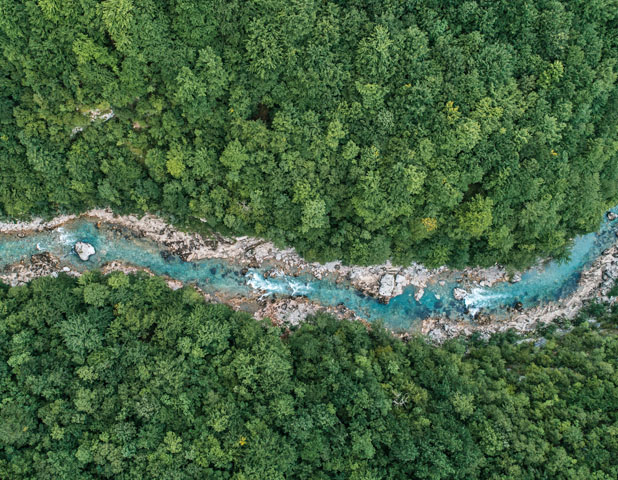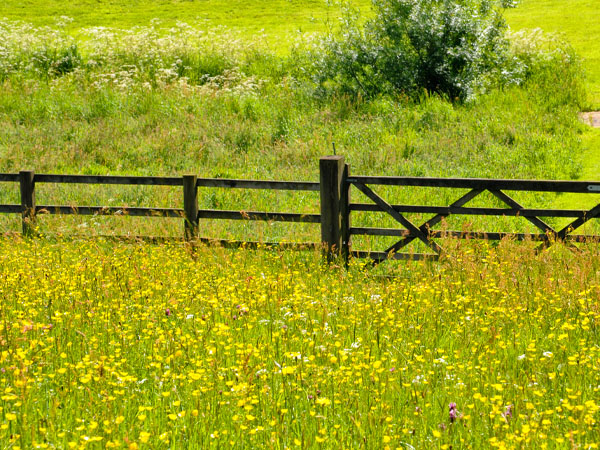The next frontier: investing in natural capital and preserving biodiversity
The next frontier: investing in natural capital and preserving biodiversity
At Gresham House, we believe that natural capital will emerge as a major global investment trend in the coming years.
A guide to investing in natural capital
Nature delivers benefits to society through the provision of four core ecosystem services:
Some of these benefits to society have been valued via well-established markets for decades, including energy, food, and timber.
Now, as a result of recent market innovations, investors have the potential to generate value from investments that target some of the other benefits that flow from nature to society.
An example of this is the sale and purchase of carbon credits, which has created a new market and places a monetary value on carbon sequestration, a regulating ecosystem service.

Why is natural capital so important?
The UN Environment Programme estimates that half the world’s GDP is dependent on nature.
However, we are using our natural resources at a pace beyond that which the earth can replenish.
Wildlife populations have declined by 69% since 19701, more than 85% of wetlands have been lost and 32% of the world’s forest area has been destroyed.2
Beginning to recognise nature as a form of capital means that we can better value the benefits it offers our societies and economies and therefore aim to protect and restore it.
The world’s natural capital is estimated to be worth $125tn (1.25x Global GDP in 2022)3
Biodiversity loss is an existential threat to human life on earth.
Biodiversity is defined as the variability among living organisms from all sources, including terrestrial, marine and other aquatic ecosystems and the ecological complexes of which they are part; this includes diversity within species, between species and of ecosystems (UN 1992).
It is an essential characteristic of nature and is critical to maintaining the quality, resilience, and quantity of ecosystems and the provision of ecosystem services on which business and society rely.4
Biodiversity and nature-positive solutions are an increasing focus for investors wanting to effect change whilst also generating the potential for robust financial returns.
Natural capital report

We released a natural capital research report with mallowstreet, a community for the institutional investment industry, where we highlight the growing appetite for natural capital investments in institutional portfolios, with half of UK asset owners saying they already invest in natural capital or will do so within the next 18 months.
Read more
What does natural capital mean to Gresham House?
At Gresham House, natural capital means providing investors with access to return-generating real assets that where possible, contribute to both the transition to a nature positive economy and a net zero economy.
Our natural capital philosophy is to invest in assets which aim to address the nature crisis by taking action across a combination of the following four pillars:
Production of sustainable natural resources
Produce sustainably managed timber and food to contribute to the circular economy and reduce agricultural impacts on nature
Avoid and mitigate climate change
Contribute to the transition to net zero by avoiding, reducing and removing carbon emissions
Restore and protect biodiversity
Contribute to the transition to a nature positive economy by protecting and restoring biodiversity by creating habitats and applying specialist land management techniques utilising natures’ intricate infrastructure
Create social value and support long term stewardship of nature
Provide community value through access to nature, create employment opportunities and protecting or securing land rights

The investment opportunity
While many investors have exposure to natural capital through assets like renewable energy (a provisioning ecosystem service) and have grasped the importance of investing in carbon related investments, other forms of natural capital, including biodiversity, remain an enigma – both from a product and return perspective.
Despite increased visibility and interest in the market, very few investors have active portfolio allocations to natural capital which contribute positively to the restoration or protection of nature.
Our recent Impact Lens research paper in association with Pensions for Purpose, Natural capital and biodiversity - where are UK asset owners on their journey? found that just 38% of those interviewed were already invested in natural capital solutions5.
Investing for our futures: Every $1 invested in restoration creates up to $30 in economic benefits6
At Gresham House, we have been investing in natural capital for many years, seen through our multi-decade track record in Forestry.
These assets produce timber which is a provisioning ecosystem service, and contribute to carbon sequestration, a regulating ecosystem service.
We are currently expanding our capability to report on the biodiversity within our forests and included initial analysis in our most recent Sustainable Investment Report.
We are also focused on developing new, interlinked solutions across real assets such as forestry and sustainable infrastructure – including carbon forestry, vertical farming, biodiversity net gain credits and habitat banks – as innovative ways to promote the potential transition towards a more sustainable economy through the protection and restoration of nature.
It is important to note that not all natural capital investments will contribute to the protection and restoration of nature. Other natural capital investments may seek to harness the benefits that nature provides society in a sustainable manner, such as productive forestry which generates timber. We are actively looking at how we can better understand the potential negative impacts that our investments have on nature, this in turn will be used to support future mitigating actions.
Measuring and comparing the value of different benefits to people from nature is complex.
Through innovative, natural capital investment solutions – from forestry to sustainable agriculture and from biodiversity net gain to carbon credits – we help investors select natural capital, nature positive investments based on the outcomes they want their portfolio to contribute towards within the context of their financial objectives.
Capital at risk. Forestry investment is not for everyone. Please read more about the investment class and read up on the risks involved before considering investing.
References
1. WWF, 2021
2. WEF New Nature Economy Report, 2020
3. Institute and Faculty of Actuaries, Natural Capital – an actuarial perspective, 26 April 2021
4. Taskforce for Nature Related Financial Disclosures
5. Within the context of the report, “natural capital solutions” were investments explicitly targeting nature-positive outcomes
6. UN environment programme, Beyond GDP, February 2022
| Afforestation | Afforestation is the direct human-induced conversion of land that has not been forested for a period of at least 50 years to forested land through planting, seeding and/or the human-induced promotion of natural seed sources.
Source: The Little REDD Book |
| Biodiversity | The variability among living organisms from all sources, including, inter alia, terrestrial, marine and other aquatic ecosystems and the ecological complexes of which they are part; this includes diversity within species, between species and of ecosystems. |
| Biodiversity credit | Biodiversity credits are a verifiable, quantifiable and tradeable financial instrument that rewards positive nature and biodiversity outcomes (e.g. species, ecosystems and natural habitats) through the creation and sale of either land or ocean-based biodiversity units over a fixed period.
Source: World Economic Forum |
| Biodiversity Metric | A biodiversity accounting tool created by Natural England that can be used for the purposes of calculating biodiversity net gain.
Source: Natural England |
| Biodiversity net gain | An approach to development, land and marine management that leaves biodiversity in a measurably better state than before a development took place.
Source: Natural England |
| Carbon credit | A financial instrument that represents a reduction or the avoidance of one tonne of carbon dioxide equivalent (tCO2e) from the atmosphere.
Source: Gold Standard |
| Carbon pricing | The cost of emitting CO2 into the atmosphere, either in the form of a fee per tonne of CO2 emitted, or an incentive offered for emitting less. Putting an economic cost on emissions is widely considered the most efficient way to encourage polluters to reduce what they emit into the atmosphere.
Source: The London School Of Economics |
| Carbon sequestration | An entity’s carbon emissions, typically divided by its revenues, though the denominator can also be square meter, per employee, unit of production, etc.
Source: USGS |
| Deforestation | Loss of natural forest as a result of: i) conversion to agriculture or other non-forest land use; ii) conversion to a tree plantation; or iii) severe and sustained degradation. |
| Ecosystem services | The contributions of ecosystems to the benefits that are used in economic and other human activities. The benefits are widely categorised into four categories: 1) Provisioning services – material outputs from nature that meet human needs such as food, drinking water, timber, critical minerals, and fossil fuels. 2) Regulating services – indirect benefits from nature generated through the regulation of ecosystem processes. Examples include mitigation of climate change through carbon sequestration, water filtration by wetlands, and crop pollination by insects. 3) Cultural services – non-material benefits from nature such as aesthetic, recreation, education, sense of place, and physical and mental wellbeing. 4) Supporting services – ecological processes that support the delivery of other ecosystem services such as nutrient cycling and soil formation.Source: Accountability Framework Initiative |
| Emissions trading scheme (ETS) | A carbon offset is a reduction or removal of emissions of carbon dioxide or other greenhouse gases made in order to compensate for emissions made elsewhere.
Source: The London School Of Economics |
| Habitat Bank | Sites where habitat is created in advance, to offset or compensate for the negative environmental impacts of development or other human activities. This habitat will need to be secured and managed long-term.
Source: Natural England |
| Kunming-Montreal Global Biodiversity Framework | The Kunming-Montreal Global Biodiversity Framework (GBF) was adopted during the fifteenth meeting of the Conference of the Parties (COP 15).This historic Framework, which supports the achievement of the Sustainable Development Goals and builds on the Convention’s previous Strategic Plans, sets out an ambitious pathway to reach the global vision of a world living in harmony with nature by 2050. Among the Framework’s key elements are 4 goals for 2050 and 23 targets for 2030 which include 30 per cent conservation of land, sea and inland waters, 30 per cent restoration of degraded ecosystems, halving the introduction of invasive species, and $500 billion/year reduction in harmful subsidies. |
| Land use change | The change from one land use category to another. Land use change refers to the modification or management of natural environments into human dominated environments, such as settlements, semi-natural, agricultural areas and other living things.
Source: TNFD, 2023 |
| Natural capital | Natural capital is the stock of renewable and non-renewable natural resources that combine to provide a flow of benefits to people and planet.
Source: Capitals Coalition |
| Natural capital approach | A natural capital approach to policy and decision making considers the value of the natural environment for people and the economy.
Source: GOV.UK, 2020 |
| Natural forest | A forest that is a natural ecosystem, possessing many or most of the characteristics of a forest native to the given site, including species composition, structure, and ecological function. |
| Nature-based solutions | Actions to protect, sustainably manage and restore natural or modified ecosystems that address societal challenges effectively and adaptively, simultaneously providing human well-being and biodiversity benefits.
Source: IUCN |
| Nature-positive | A high-level goal and concept describing a future state of nature (e.g., biodiversity, ecosystem services and natural capital) which is greater than the current state.
Source: TNFD, 2023 |
| Payments for ecosystem services | Payments for Ecosystem Services is the name given to a variety of arrangements through which the beneficiaries of environmental services, from watershed protection and forest conservation to carbon sequestration and landscape beauty, reward those whose lands provide these services with subsidies or market payments.
Source: WWF |
| Primary forest | A forest that has never been logged and has developed following natural disturbances and under natural processes, regardless of its age. |
| Sustainable Agriculture | Sustainable agriculture is farming in sustainable ways meeting society’s present food and textile needs, without compromising the ability for current or future generations to meet their needs.
Source: Sustainable Agriculture Research & Education Program |
| Conversion | Change of a natural ecosystem to another land use or profound change in a natural ecosystem’s species composition, structure, or function. Deforestation is one form of conversion. |
| Net Deforestation | The difference in forest area between two points in time, taking into account both losses from deforestation and gains from forest regeneration and restoration. |
|
Forest
|
Land spanning more than 0.5 hectares with trees higher than 5 meters and a canopy cover of more than 10 percent, or trees able to reach these thresholds in situ. It does not include land that is predominantly under agricultural or other land use. Forest includes natural forests and tree plantations. For the purpose of implementing no-deforestation supply chain commitments, the focus is often on preventing the conversion of natural forests. |
| Biodiversity financing Oap | The difference between how much is currently spent and how much is needed annually in the next ten years to protect the most important biodiversity and the services it provides
Source: Paulson Institute |
Natural Capital leadership team
Get in touch for more information and to find out more.
 |
 |
 |
| Heather Fleming | Claire Glennon | Alastair Leather |
| Managing Director, Institutional Business | Head of UK Institutional Sales | Director, Institutional Distribution |
| h.fleming@greshamhouse.com | c.glennon@greshamhouse.com | a.leather@greshamhouse.com |
Related content
Want to keep up to date?
Subscribe using the form below to receive regular updates on natural capital.
 Gresham House
Specialist asset management
Gresham House
Specialist asset management














